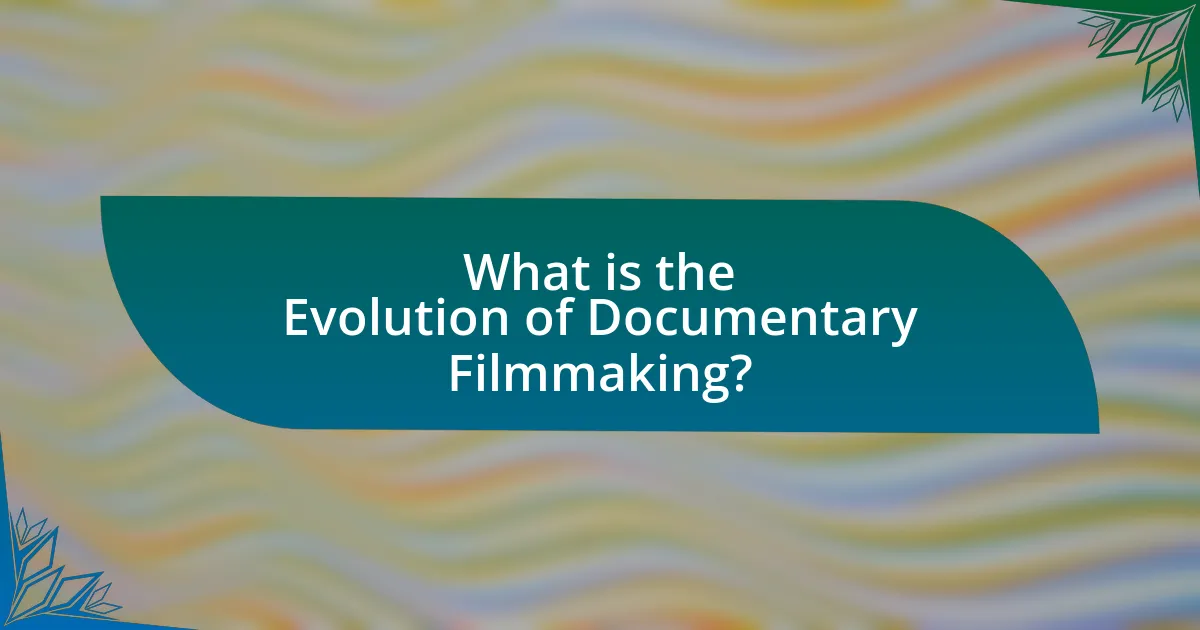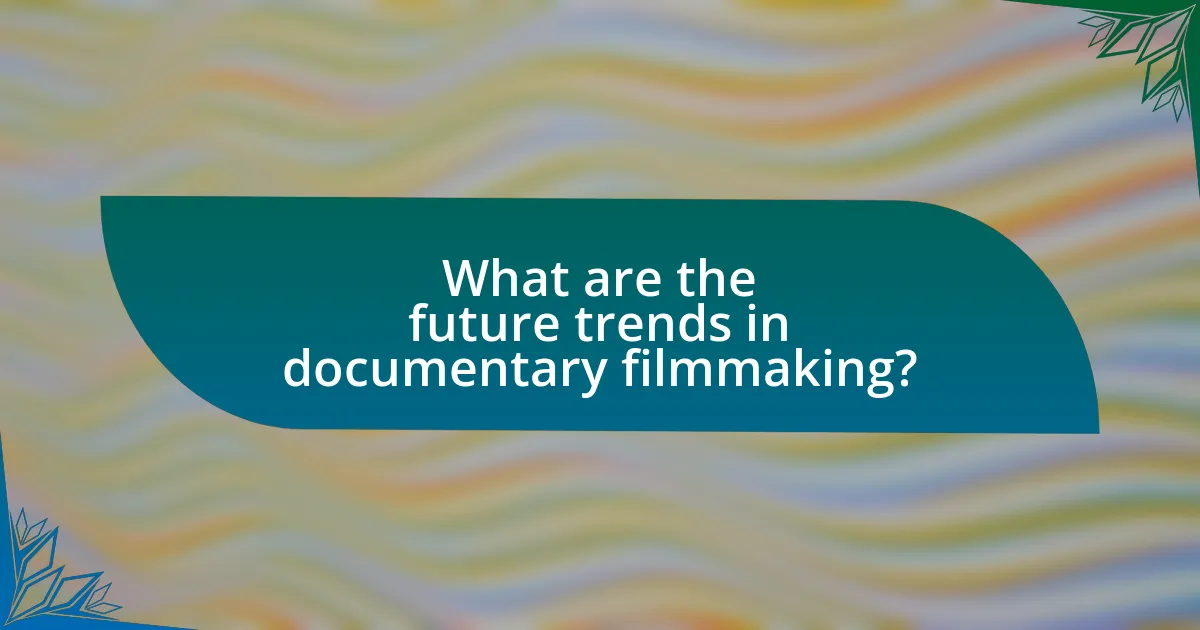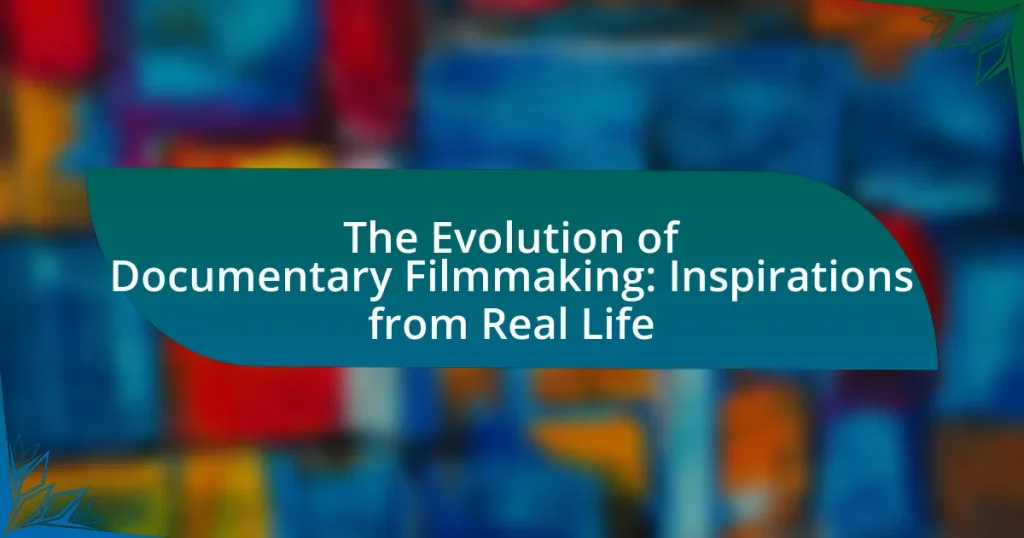The article examines the evolution of documentary filmmaking, tracing its development from the late 19th century to the present day. It highlights key phases, including the early observational techniques of the Lumière brothers, the narrative structures introduced in the 1920s and 1930s, and the rise of immersive styles like direct cinema in the post-World War II era. The impact of technological advancements, such as digital filmmaking and streaming platforms, is discussed, along with the influence of social movements and real-life inspirations on documentary content. Additionally, the article addresses ethical considerations, audience expectations, and future trends shaping the documentary landscape.

What is the Evolution of Documentary Filmmaking?
The evolution of documentary filmmaking has progressed through several distinct phases, beginning with early forms in the late 19th century, such as the Lumière brothers’ short films, which captured real-life events. This initial phase laid the groundwork for the genre, emphasizing observational techniques and factual representation.
In the 1920s and 1930s, documentary filmmaking evolved with the introduction of sound and more narrative structures, exemplified by Robert Flaherty’s “Nanook of the North,” which blended documentary with storytelling elements. The post-World War II era saw the rise of direct cinema and cinéma vérité, characterized by a more immersive approach, as seen in films like “Primary” by Robert Drew, which utilized handheld cameras to capture events as they unfolded.
The 1960s and 1970s marked a significant shift towards more personal and political documentaries, with filmmakers like Frederick Wiseman and Barbara Kopple exploring social issues and human experiences. The advent of digital technology in the late 20th century further transformed the landscape, making filmmaking more accessible and leading to the rise of independent documentaries.
Today, documentary filmmaking continues to evolve with the integration of new media platforms and formats, including streaming services, which have expanded the reach and diversity of documentary content. This ongoing evolution reflects the genre’s adaptability and its commitment to portraying real-life narratives.
How has documentary filmmaking changed over the decades?
Documentary filmmaking has evolved significantly over the decades, transitioning from traditional, linear storytelling to more diverse and innovative formats. In the early 20th century, documentaries primarily focused on observational styles, capturing real-life events without much narrative structure. By the 1960s and 1970s, filmmakers like Frederick Wiseman and the Direct Cinema movement introduced a more immersive approach, emphasizing authenticity and spontaneity.
The advent of digital technology in the late 1990s and early 2000s further transformed the medium, allowing for lower production costs and greater accessibility, which led to a surge in independent documentaries. Additionally, the rise of streaming platforms has shifted the distribution landscape, enabling filmmakers to reach wider audiences and explore niche topics. According to a 2021 report by the International Documentary Association, the number of documentary films produced annually has increased dramatically, reflecting a growing public interest in real-life stories.
What key historical events influenced the evolution of documentary filmmaking?
Key historical events that influenced the evolution of documentary filmmaking include the invention of the motion picture camera in the late 19th century, the rise of cinema as a popular medium in the early 20th century, and significant global conflicts such as World War I and World War II. The invention of the motion picture camera allowed filmmakers to capture real-life events, leading to the creation of early documentaries like “Nanook of the North” in 1922, which showcased the life of an Inuit family. The early 20th century saw the establishment of documentary as a distinct genre, particularly with the work of filmmakers like Robert Flaherty and John Grierson, who emphasized the importance of social issues and realism. Additionally, World War I and World War II spurred the production of propaganda films, which further solidified the role of documentaries in shaping public perception and historical narrative. These events collectively contributed to the development of documentary filmmaking as a powerful tool for storytelling and social commentary.
How have technological advancements impacted documentary filmmaking?
Technological advancements have significantly transformed documentary filmmaking by enhancing accessibility, production quality, and distribution methods. The introduction of affordable digital cameras and editing software has democratized the filmmaking process, allowing more filmmakers to create high-quality documentaries without the need for expensive equipment. For instance, the rise of platforms like YouTube and Vimeo has enabled filmmakers to reach global audiences directly, bypassing traditional distribution channels. Additionally, advancements in streaming technology have facilitated the consumption of documentaries on various devices, increasing viewership. According to a report by the International Documentary Association, the number of documentaries produced has surged, reflecting the impact of these technological changes on the industry.
Why is real life a significant inspiration for documentary filmmakers?
Real life serves as a significant inspiration for documentary filmmakers because it provides authentic narratives that resonate with audiences. Documentaries aim to depict real events, people, and issues, allowing filmmakers to explore complex social, political, and cultural themes. For instance, the documentary “13th” by Ava DuVernay examines the intersection of race, justice, and mass incarceration in the United States, drawing directly from historical facts and contemporary societal issues. This reliance on real-life subjects not only enhances the credibility of the film but also fosters a deeper emotional connection with viewers, making the stories more impactful and relatable.
What themes from real life are commonly explored in documentaries?
Common themes from real life explored in documentaries include social justice, environmental issues, historical events, personal stories, and cultural identity. Documentaries often focus on social justice to highlight inequalities and advocate for change, as seen in films like “13th,” which examines racial injustice in the U.S. Environmental issues are frequently addressed, with documentaries such as “An Inconvenient Truth” raising awareness about climate change. Historical events are also a significant theme, providing insights into pivotal moments, as demonstrated by “The Act of Killing,” which explores the Indonesian mass killings of 1965-66. Personal stories are showcased to evoke empathy and understanding, exemplified by “Won’t You Be My Neighbor?” which chronicles Fred Rogers’ impact on children’s television. Lastly, cultural identity is explored to celebrate diversity and heritage, as seen in “Rumble: The Indians Who Rocked the World,” which highlights the influence of Native American musicians.
How do filmmakers choose their subjects based on real-life inspirations?
Filmmakers choose their subjects based on real-life inspirations by identifying compelling stories that resonate with audiences and reflect societal issues. They often conduct extensive research, including interviews, archival footage, and personal narratives, to uncover unique perspectives and experiences. For instance, documentaries like “Won’t You Be My Neighbor?” about Fred Rogers highlight the impact of individual lives on broader cultural themes, demonstrating how filmmakers select subjects that not only tell a story but also provoke thought and discussion. This approach is supported by the increasing popularity of documentaries, which accounted for 15% of the U.S. box office in 2020, indicating a strong audience interest in real-life narratives.
What are the different styles of documentary filmmaking?
The different styles of documentary filmmaking include expository, observational, participatory, reflexive, and performative. Expository documentaries focus on delivering a specific argument or narrative, often using voice-over narration to guide the viewer. Observational documentaries capture real-life events as they unfold, allowing the audience to witness the subject without interference. Participatory documentaries involve the filmmaker interacting with the subjects, often blurring the lines between observer and participant. Reflexive documentaries emphasize the filmmaking process itself, prompting viewers to consider the construction of the documentary. Performative documentaries prioritize the filmmaker’s personal perspective and emotional response, often using artistic elements to convey their message. Each style serves distinct purposes and engages audiences in unique ways, reflecting the diverse approaches within the documentary genre.
What distinguishes observational documentaries from participatory ones?
Observational documentaries are characterized by their aim to capture reality without interference, while participatory documentaries involve the filmmaker actively engaging with the subjects. In observational documentaries, filmmakers adopt a fly-on-the-wall approach, allowing events to unfold naturally without their influence, which emphasizes authenticity and spontaneity. In contrast, participatory documentaries feature the filmmaker’s presence and interaction, often shaping the narrative through interviews or direct involvement, which can lead to a more subjective portrayal of the subject matter. This distinction is crucial in understanding the different methodologies and impacts of these documentary styles on audience perception and storytelling.
How do narrative and expository styles differ in their approach to real-life stories?
Narrative and expository styles differ significantly in their approach to real-life stories. Narrative style focuses on storytelling elements such as character development, plot, and emotional engagement, often presenting events in a chronological sequence to create a compelling narrative arc. In contrast, expository style emphasizes factual information and analysis, aiming to inform or explain a subject without the embellishments of storytelling, often using a more structured format to present data and evidence. For example, documentaries that employ narrative style may follow a protagonist’s journey, while expository documentaries might present statistics and expert interviews to convey information about a social issue. This distinction highlights how narrative engages audiences emotionally, whereas expository seeks to educate them through clear, objective presentation.

What are the key influences on documentary filmmaking?
Key influences on documentary filmmaking include historical events, social movements, technological advancements, and cultural contexts. Historical events shape the narratives and themes explored in documentaries, as filmmakers often seek to document and analyze significant occurrences, such as wars or social upheavals. Social movements, like civil rights or environmental activism, inspire filmmakers to highlight issues and advocate for change through their work. Technological advancements, particularly in camera and editing technology, have expanded the possibilities for storytelling and accessibility in documentary filmmaking. Cultural contexts, including societal values and norms, also influence the subjects chosen and the perspectives presented in documentaries, reflecting the complexities of real-life experiences.
How do cultural and social movements shape documentary content?
Cultural and social movements significantly shape documentary content by influencing the themes, narratives, and perspectives presented in films. For instance, the civil rights movement in the United States led to the creation of documentaries that highlighted racial injustices and the struggle for equality, such as “Eyes on the Prize,” which documented the history of the civil rights movement from 1954 to 1985. Similarly, the feminist movement has inspired documentaries like “Miss Representation,” which critiques the portrayal of women in media and challenges societal norms. These movements not only provide subject matter but also encourage filmmakers to adopt specific viewpoints that resonate with contemporary social issues, thereby reflecting and amplifying the voices of marginalized communities.
What role does activism play in the creation of documentaries?
Activism plays a crucial role in the creation of documentaries by driving the narrative and focus on social issues. Documentaries often emerge from activist movements, as filmmakers seek to highlight injustices, raise awareness, and inspire change. For instance, the documentary “13th,” directed by Ava DuVernay, explores the intersection of race, justice, and mass incarceration in the United States, reflecting the activism surrounding racial equality and criminal justice reform. This connection between activism and documentary filmmaking not only informs the content but also mobilizes audiences to engage with critical societal challenges.
How do filmmakers respond to societal issues through their work?
Filmmakers respond to societal issues through their work by creating narratives that reflect, critique, and provoke discussions on these issues. For instance, documentaries like “13th” by Ava DuVernay address systemic racism and mass incarceration in the United States, using historical context and statistics to highlight the ongoing impact of these societal problems. This approach not only raises awareness but also encourages audiences to engage with and reflect on the complexities of social justice, thereby fostering a deeper understanding of the issues at hand.
What impact do audience expectations have on documentary filmmaking?
Audience expectations significantly influence documentary filmmaking by shaping the narrative style, content selection, and production techniques employed by filmmakers. Documentaries are often crafted to meet the anticipations of viewers regarding authenticity, emotional engagement, and informative value. For instance, a study by the University of Southern California found that documentaries perceived as more relatable and emotionally resonant tend to attract larger audiences, indicating that filmmakers often tailor their approaches to align with these expectations. This alignment can lead to the incorporation of dramatic storytelling elements or the use of specific visual styles that enhance viewer engagement, ultimately affecting the overall impact and reception of the documentary.
How do filmmakers balance artistic vision with audience engagement?
Filmmakers balance artistic vision with audience engagement by integrating personal storytelling with universal themes that resonate with viewers. This approach allows filmmakers to maintain their unique style while ensuring that the content remains relatable and compelling. For instance, successful documentaries often blend innovative cinematography and narrative techniques with accessible subject matter, which attracts a broader audience. A notable example is the documentary “Won’t You Be My Neighbor?” which combines the filmmaker’s artistic interpretation of Fred Rogers’ life with themes of kindness and community, resulting in both critical acclaim and audience popularity. This strategy demonstrates that filmmakers can effectively merge their creative intentions with the expectations and interests of their audience.
What trends in audience preferences are currently shaping documentaries?
Current trends in audience preferences shaping documentaries include a demand for authenticity, diverse storytelling, and interactive formats. Audiences increasingly favor documentaries that present real-life stories with genuine perspectives, as evidenced by the rise of personal narratives and first-person accounts in popular titles. Additionally, there is a growing interest in documentaries that explore underrepresented voices and cultures, reflecting a broader societal push for inclusivity. Interactive documentaries, which allow viewers to engage with content in a more immersive way, are also gaining traction, as seen in platforms that offer choose-your-own-adventure styles. These trends indicate a shift towards more engaging, relatable, and socially conscious documentary filmmaking.

What are the future trends in documentary filmmaking?
Future trends in documentary filmmaking include increased use of immersive technologies, such as virtual reality (VR) and augmented reality (AR), which enhance viewer engagement by providing interactive experiences. Additionally, the rise of streaming platforms has shifted distribution models, allowing for broader access and diverse storytelling formats. Data-driven storytelling is also becoming prominent, as filmmakers utilize analytics to understand audience preferences and tailor content accordingly. Furthermore, social issues and personal narratives are gaining more focus, reflecting a societal shift towards authenticity and representation in media. These trends are supported by industry reports indicating a growing demand for innovative formats and diverse voices in documentary content.
How is technology influencing the future of documentary storytelling?
Technology is significantly influencing the future of documentary storytelling by enhancing accessibility, interactivity, and production quality. Innovations such as virtual reality (VR) and augmented reality (AR) allow audiences to engage with narratives in immersive ways, creating a more profound emotional connection to the subject matter. For instance, projects like “The Displaced,” which uses VR to tell the stories of refugee children, demonstrate how technology can provide a first-person perspective that traditional formats cannot achieve. Additionally, advancements in mobile filmmaking and editing software enable filmmakers to produce high-quality documentaries with lower budgets, democratizing the medium and allowing diverse voices to emerge. According to a report by the International Documentary Association, the rise of streaming platforms has also expanded the reach of documentaries, making them accessible to global audiences and increasing their impact.
What role do streaming platforms play in the distribution of documentaries?
Streaming platforms serve as crucial distribution channels for documentaries, significantly expanding their reach and accessibility. These platforms, such as Netflix, Amazon Prime Video, and Hulu, provide filmmakers with a global audience, allowing documentaries to be viewed by millions without the limitations of traditional theatrical releases. According to a 2021 report by the International Documentary Association, streaming services accounted for over 50% of documentary viewership, highlighting their dominance in the market. This shift not only democratizes access to diverse stories but also encourages the production of more varied and niche documentaries, as platforms seek unique content to attract subscribers.
How are virtual reality and interactive media changing the documentary landscape?
Virtual reality and interactive media are transforming the documentary landscape by enhancing viewer engagement and immersion. These technologies allow audiences to experience stories in a more participatory manner, enabling them to explore environments and narratives actively rather than passively watching. For instance, projects like “The Displaced,” which uses VR to tell the stories of refugees, demonstrate how immersive experiences can evoke empathy and a deeper understanding of complex issues. Research indicates that immersive storytelling can increase emotional connection and retention of information, making documentaries more impactful.
What ethical considerations are emerging in documentary filmmaking?
Emerging ethical considerations in documentary filmmaking include issues of consent, representation, and the impact of storytelling on subjects. Filmmakers are increasingly required to obtain informed consent from participants, ensuring they understand how their stories will be portrayed and the potential consequences. Additionally, the representation of marginalized communities raises concerns about stereotyping and exploitation, prompting filmmakers to adopt more responsible practices. The rise of participatory and observational styles has also led to debates about the filmmaker’s role and the ethical implications of their presence in the narrative. These considerations are underscored by the need for transparency and accountability in the filmmaking process, as highlighted by organizations like the International Documentary Association, which advocates for ethical standards in documentary production.
How do filmmakers navigate the challenges of representation and consent?
Filmmakers navigate the challenges of representation and consent by implementing ethical guidelines and engaging with the communities they depict. They prioritize informed consent by ensuring that subjects understand how their stories will be portrayed, often involving them in the creative process. For instance, the documentary “The Act of Killing” involved former Indonesian death squad leaders in reenacting their experiences, which raised ethical questions about representation and consent. This approach highlights the importance of transparency and collaboration, allowing filmmakers to address power dynamics and cultural sensitivities effectively. By adhering to these practices, filmmakers can create more authentic and respectful representations while minimizing the risk of exploitation.
What best practices should filmmakers follow to ensure ethical storytelling?
Filmmakers should prioritize transparency, informed consent, and cultural sensitivity to ensure ethical storytelling. Transparency involves clearly communicating the intent and purpose of the film to subjects, which fosters trust and understanding. Informed consent requires filmmakers to obtain explicit permission from participants, ensuring they are aware of how their stories will be portrayed. Cultural sensitivity entails respecting the backgrounds and beliefs of individuals and communities represented in the film, which can prevent misrepresentation and exploitation. These practices are supported by ethical guidelines from organizations like the International Documentary Association, which emphasizes the importance of integrity and respect in documentary filmmaking.
What practical tips can aspiring documentary filmmakers follow?
Aspiring documentary filmmakers should focus on thorough research and storytelling to create impactful films. Conducting in-depth research helps filmmakers understand their subjects and context, which is crucial for authenticity. Additionally, developing a compelling narrative structure engages audiences and enhances the emotional resonance of the documentary. Filmmakers should also prioritize building relationships with their subjects, as trust can lead to more genuine and revealing footage. Furthermore, mastering technical skills in cinematography and editing is essential for producing high-quality content. According to a study by the International Documentary Association, effective storytelling and technical proficiency significantly contribute to a documentary’s success and audience engagement.
How can filmmakers effectively research and select their documentary topics?
Filmmakers can effectively research and select their documentary topics by identifying relevant social issues, conducting thorough background research, and engaging with communities related to the subject matter. This approach ensures that the chosen topic resonates with audiences and is grounded in factual accuracy. For instance, filmmakers can utilize academic journals, news articles, and interviews with experts to gather diverse perspectives and data on the topic. Additionally, exploring existing documentaries can provide insights into gaps in coverage or unique angles that have not been addressed. By combining these methods, filmmakers can create compelling narratives that reflect real-life inspirations and contribute meaningfully to public discourse.
What strategies can enhance storytelling in documentary filmmaking?
Effective strategies that can enhance storytelling in documentary filmmaking include utilizing strong narrative structures, incorporating character-driven arcs, and employing immersive visuals. Strong narrative structures, such as the three-act format, help to create a compelling flow that engages viewers. Character-driven arcs allow audiences to connect emotionally with subjects, making the story more relatable and impactful. Immersive visuals, including high-quality cinematography and thoughtful editing, enhance the storytelling experience by drawing viewers into the documentary’s world. Research indicates that documentaries that effectively combine these elements tend to achieve higher viewer engagement and retention rates, as evidenced by successful films like “Won’t You Be My Neighbor?” which utilized these strategies to tell the story of Fred Rogers.


